More than 3000 species of earthworms are distributed worldwide and many more are yet to be discovered. 18 families of class Oligochaeta have several general of earthworms. In India out of these 18 families, the earthworms of 7 families are found.
Among these, Megascolidae is largest genera. The members of this genus Pheretima, Perionyx, Eutyphaeus and Polypheretima are distributed in north India and other members like Drawida, megascolex etc. are distributed in south India. Drawida grandis is the longest earthworm in India.
Pheretima posthuma is a fossorial animal that lives in moist soil burrows. It makes its burrows only in loamy and sandy soil. This burrowing habit provides its protection and also helps in respiration indirectly. Generally it lives in the upper layers of damp soil which is rich in dead and decaying matter. In summer, when the top soil is dry, earthworms burrow deep into the soil. The earthworm burrows are lined by slimy secretion of its body.
Size- A fully grown, mature worm measures bout 3-5 mm in width and 150 mm in length.
Shape- Pheretima posthuma is long, elongated, cylindrical and narrow in shape. Its body shape is well suited for burrowing habit. It is bisymmetric animal. Its anterior end is slightly pointed whereas the posterior end is blunt. A little behind the anterior end it is thickest.
Color- The dorsal surface of the body is dark brown in color due to the presence of the pigment called porphyrin. This pigment protects the animal from harmful UV rays. The dorsal surface also carries a dark colored median line which is due to the presence of dorsal blood vessel which is seen through the integument.
Body segmentation- The body of Pheretima posthuma is soft and naked. It is divided prostomium, trunk and pygidium. Prostomium is fleshy lobe which overhangs mouth, trunk has 100-120 similar segments called as metameres or somites and pygidium bears anus. The segments are separated externally by intersegmental grooves and internally by corresponding intersegmental septa. The external segmentation corresponds with the internal segmentation.
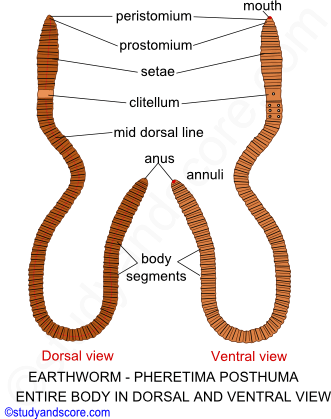
New segments are formed from the germinal zone located in front of the pygidium. Hence the old segments are at the anterior and the new segments are formed at the posterior end. The first segment of the body is peristomium which is the oldest segment of the body, while the preanal segment is the youngest segment of the body.
Head- Earthworm does not have distinct head and also sense organs like eyes, cirri, tentacles are absent. The first segment of the body at the anterior end is called buccal segment or peristomium. Peristomium bears terminal, crescentic mouth. The mouth is bordered by anterior edge of peristomium and overhung by prostomium.
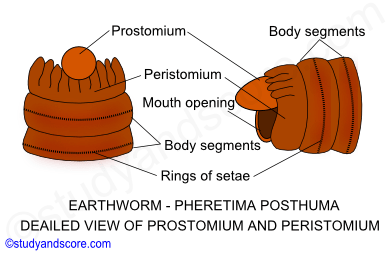
Clitellum- In mature earthworms, a prominent circular band around the segments 14-16 is called cingulum or clitellum. Based on the location of the clitellum, the body of the earthworm is distinguished into three regions namely pre-clitellar, clitellar and post-clitellar regions.
Genital papillae- These are two pairs of conspicuous rounded elevations, one pair each in the 17th and 19th segments on the ventral surface. Each papilla bears shallow cup-like depression at its top which acts as sucker during copulation.
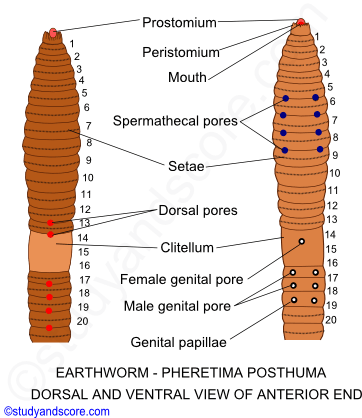
About middle of each segment there is a ring of tiny curved bristles called as setae. Setae are also known as chaetae. They are formed of a horny nitrogenous organic substance known as chitin. On each body segment there are about 80 -120 setae. They are absent on the peristomium, pygidium and clitellum.
Structure of setae: Each seta is an ‘S’ shaped and faint yellowish in color. It has a pointed distal end, a blunt proximal end and a central swelling called nodulus. About 1/3 of the setae projects above the body wall which is called the neck and the part embedded in the setal sac is the base. The setal sac is formed by the invagination of the epidermis of the body wall. Each seta is formed in the setal sac. One pair of protractor muscles and a retractor muscle are associated with each setal sac.
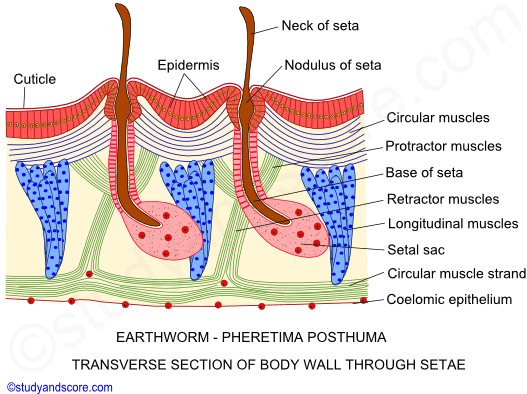
The protrusion and retraction of the setae are effected by protractor and retractor muscles respectively. Setae grip the soil to help the earthworm move about and sense the environment. Setae are absent in the peristomium and pygidium. Setae are dropped in the mature worm from the region of the clitellum.
Arrangement of setae: The arrangement of the setae is one factor that helps in the identification of earthworms.
Eg: Pheretima posthuma
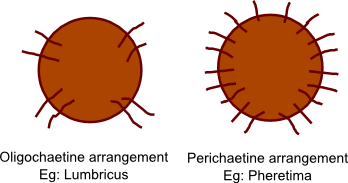
Eg: Lumbricus

- Share with your friends! -
Login to post your comment here...
- or with social Account -